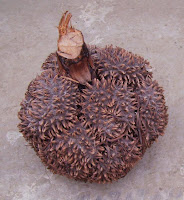 1850-1860: "This is a lady's scoring kit for archery. These usually hung from a lady archer's belt together with a quiver, a spare string, and sometimes a purse containing shillings. Three golds (arrows in the centre) entitled a competitor to receive a shilling from each opponent.
1850-1860: "This is a lady's scoring kit for archery. These usually hung from a lady archer's belt together with a quiver, a spare string, and sometimes a purse containing shillings. Three golds (arrows in the centre) entitled a competitor to receive a shilling from each opponent.The kit has three parts: The acorn-shaped cup or pot contained grease (a mixture of mutton fat and tallow) which help the finger protectors or shooting glove slide more easily off the bowstring.
The pricker is the tubular object with a sharp pointed stiletto used for marking scores onto the card disc which holds a circular replaceable printed paper bulls-eye card with circles in gold, red, white, black and blue. Players scored nine for gold, seven for red, five for blue three for black and one for white." Link











